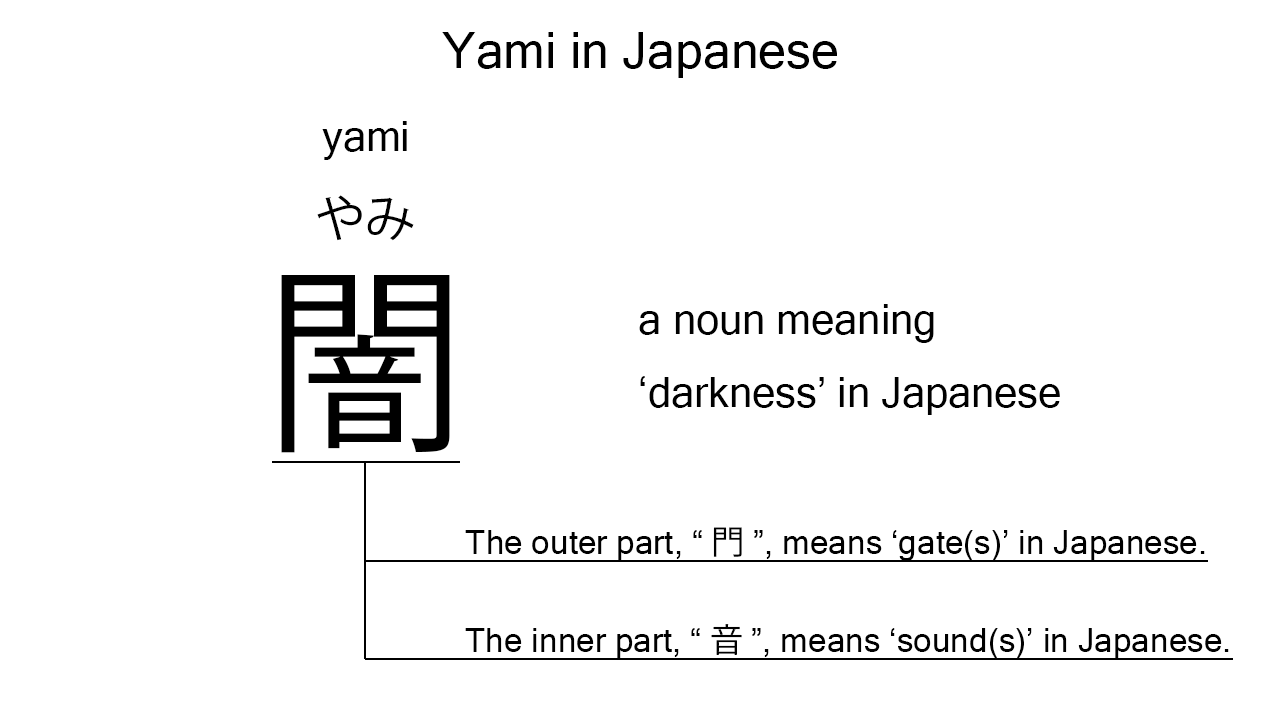What does “yami” mean in Japanese?
Native speakers say “yami” to mean ‘darkness’ in Japanese. Perhaps, some Japanese learners know this word as it is sometimes used in Japanese movies, video games, manga, anime, and the like. In this blog post, however, I will explain this word in detail based on its kanji character. And also, I will explain how to use it through example sentences. My explanations would help Japanese learners understand “yami” more clearly. Then, let’s get started!
Contents
Definition and meaning of “yami”
Let me start with the definition and meaning of “yami”.
- yami – 闇 (やみ) : a noun meaning ‘darkness’ in Japanese.
Native speakers use this noun to refer to a place or space where there is no light. So, the usage is very similar to that of “darkness”, I think.
The definition and meaning are simple and clear. To understand this noun more clearly, however, let me explain its kanji character in detail.
Yami in kanji
The kanji character of “yami” consists of the following two parts:
- 門 : a kanji character widely used to mean ‘gate’ in Japanese.
- 音 : a kanji character widely used to mean ‘sound’ in Japanese. This kanji can also be found in other words like “ongaku“.
From these two parts, we can understand that the kanji character of “yami” literally means ‘sounds inside a gate’ in Japanese. This literal interpretation is a bit weird, but still understandable, I think. The kanji character implies the existence of a place behind the gate which only sounds can go through. In other words, it refers to a place where light cannot exist.

When we meet new kanji characters, we should check their parts in detail to understand their meanings clearly and deeply. In many cases, kanji parts tell us a lot about the meanings of the characters they form. Actually, here, we could get the better understanding of “yami” through the detailed check above.
So far, I’ve explained the definition and meaning of “yami” together with its kanji character. Then, let me explain how to use it through the example sentences below.
Example #1: how to say “darkness” in Japanese
boku tachi wa yami no naka de tatakau – 僕達は闇の中で戦う (ぼくたちはやみのなかでたたかう)
We fight in the darkness.
Below are the new words used in the example sentence.
- boku – 僕 (ぼく) : a pronoun meaning ‘I’ in Japanese. This is used mainly by boys and young males.
- tachi – 達 (たち) : a suffix used after a noun or pronoun to make its plural form. In the example, this is used after “boku” to make its plural form, “boku tachi”, which means ‘we’ in Japanese. Learn more about Japanese plural.
- wa – は : a binding particle working as a case marker or topic marker. In the example, this works after “boku tachi” to make the subject in the sentence.
- no – の : a case particle joining two nouns. Normally, the first one can work as a modifier to describe the second. In the example, this works to join “yami” and “naka”. The formed phrase literally means ‘the inside of the darkness’ in Japanese. Word orders in Japanese and English are different, but the role of this case particle is very similar to that of the English preposition, “of”.
- naka – 中 (なか) : a noun meaning ‘inside’ in Japanese.
- de – で : a case particle used to say where someone does something. In the example, this is used after “yami no naka” to say where the speakers fight.
- tatakau – 戦う (たたかう) : a verb meaning ‘to fight’ or such in Japanese.
This is a typical usage of “yami”. In the example, it works as a part of the noun phrase, “yami no naka”, which can mean ‘in the darkness’ in Japanese. When we want to say “darkness” in Japanese, anyway, this noun is a very good option.
Example #2: another usage of “yami”
hikari to yami no hazama – 光と闇の狭間 (ひかりとやみのはざま)
the place between the light and the dark
Below are the new words used in the example.
- hikari – 光 (ひかり) : a noun meaning ‘light’ in Japanese.
- to – と : a case particle working as a parallel marker. In the example, this works to join “hikari” and “yami” with adding the meaning of ‘and’.
- hazama – 狭間 (はざま) : a noun referring to a place between two.
This is another typical usage of “yami”. In this example, it works to mean ‘the dark’ in Japanese. When we want to refer to a place where light doesn’t exist, this noun can be a good option.
Summary
In this blog post, I’ve explained the definition and meaning of “yami” in detail based on its kanji character. And also, I’ve explained how to use it through the example sentences. Let me summarize them as follows.
- yami – 闇 (やみ) : a noun meaning ‘darkness’ in Japanese. This kanji character consists of two parts: “門” and “音”. The first one means a gate; the second means sounds. So, this kanji character literally means ‘sounds inside a gate’ in Japanese. This literal interpretation is a bit weird, but still understandable, I think. The kanji character implies the existence of a place behind the gate which only sounds can go through. In other words, it refers to a place where light cannot exist.
Hope my explanations are understandable and helpful for Japanese learners.